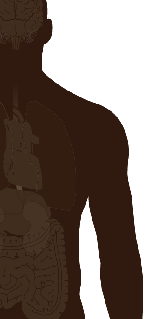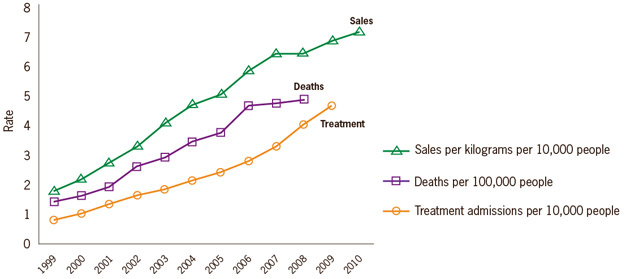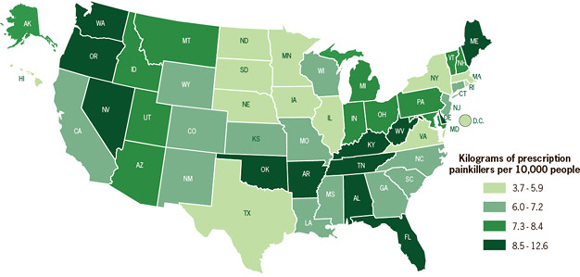Prescription Painkiller Overdoses in the US
Vital Signs
November 2011



15,000
Nearly 15,000 people die every year of overdoses involving prescription painkillers.

1 in 20
In 2010, 1 in 20 people in the US (age 12 or older) reported using prescription painkillers for nonmedical reasons in the past year.

1 Month
Enough prescription painkillers were prescribed in 2010 to medicate every American adult around-the-clock for a month.
Deaths from prescription painkillers* have reached epidemic levels in the past decade. The number of overdose deaths is now greater than those of deaths from heroin and cocaine combined. A big part of the problem is nonmedical use of prescription painkillers—using drugs without a prescription, or using drugs just for the “high” they cause. In 2010, about 12 million Americans (age 12 or older) reported nonmedical use of prescription painkillers in the past year.
Enough prescription painkillers were prescribed in 2010 to medicate every American adult around-the-clock for a month. Although most of these pills were prescribed for a medical purpose, many ended up in the hands of people who misused or abused them.
Improving the way prescription painkillers are prescribed can reduce the number of people who misuse, abuse or overdose from these powerful drugs, while making sure patients have access to safe, effective treatment.
* “Prescription painkillers” refers to opioid or narcotic pain relievers, including drugs such as Vicodin (hydrocodone), OxyContin (oxycodone), Opana (oxymorphone), and methadone.
Overdose deaths from prescription painkillers have skyrocketed during the past decade.
Prescription painkiller overdoses are a public health epidemic.
- Prescription painkiller overdoses killed nearly 15,000 people in the US in 2008. This is more than 3 times the 4,000 people killed by these drugs in 1999.
- In 2010, about 12 million Americans (age 12 or older) reported nonmedical use of prescription painkillers in the past year.
- Nearly half a million emergency department visits in 2009 were due to people misusing or abusing prescription painkillers.
- Nonmedical use of prescription painkillers costs health insurers up to $72.5 billion annually in direct health care costs.
Certain groups are more likely to abuse or overdose on prescription painkillers.
- Many more men than women die of overdoses from prescription painkillers.
- Middle-aged adults have the highest prescription painkiller overdose rates.
- People in rural counties are nearly twice as likely to overdose on prescription painkillers as people in big cities.
- Whites and American Indian or Alaska Natives are more likely to overdose on prescription painkillers
- About 1 in 10 American Indian or Alaska Natives aged 12 or older used prescription painkillers for nonmedical reasons in the past year, compared to 1 in 20 whites and 1 in 30 blacks.
The supply of prescription painkillers is larger than ever.
- The quantity of prescription painkillers sold to pharmacies, hospitals, and doctors’ offices was 4 times larger in 2010 than in 1999.
- Many states report problems with “pill mills” where doctors prescribe large quantities of painkillers to people who don’t need them medically. Some people also obtain prescriptions from multiple prescribers by “doctor shopping.”
Some states have a bigger problem with prescription painkillers than others.
- Prescription painkiller sales per person were more than 3 times higher in Florida, which has the highest rate, than in Illinois, which has the lowest.
- In 2008/2009, nonmedical use of painkillers in the past year ranged from 1 in 12 people (age 12 or older) in Oklahoma to 1 in 30 in Nebraska.
- States with higher sales per person and more nonmedical use of prescription painkillers tend to have more deaths from drug overdoses.
Rates of prescription painkiller sales, deaths and substance abuse treatment admissions (1999-2010)

SOURCES: National Vital Statistics System, 1999-2008; Automation of Reports and Consolidated Orders System (ARCOS) of the Drug Enforcement Administration (DEA), 1999-2010; Treatment Episode Data Set, 1999-2009
Amount of prescription painkillers sold by state per 10,000 people (2010)

SOURCE: Automation of Reports and Consolidated Orders System (ARCOS) of the Drug Enforcement Administration (DEA), 2010
Drug overdose death rates by state per 100,000 people (2008)

SOURCE: National Vital Statistics System, 2008
The US government is
- Tracking prescription drug overdose trends to better understand the epidemic.
- Educating health care providers and the public about prescription drug abuse and overdose.
- Developing, evaluating and promoting programs and policies shown to prevent and treat prescription drug abuse and overdose, while making sure patients have access to safe, effective pain treatment.
States can
- Start or improve prescription drug monitoring programs (PDMPs), which are electronic databases that track all prescriptions for painkillers in the state.
- Use PDMP, Medicaid, and workers’ compensation data to identify improper prescribing of painkillers.
- Set up programs for Medicaid, workers’ compensation programs, and state-run health plans that identify and address improper patient use of painkillers.
- Pass, enforce and evaluate pill mill, doctor shopping and other laws to reduce prescription painkiller abuse.
- Encourage professional licensing boards to take action against inappropriate prescribing.
- Increase access to substance abuse treatment.
Individuals can
- Use prescription painkillers only as directed by a health care provider.
- Make sure they are the only one to use their prescription painkillers. Not selling or sharing them with others helps prevent misuse and abuse.
- Store prescription painkillers in a secure place and dispose of them properly.*
- Get help for substance abuse problems if needed (1-800-662-HELP).
Health insurers can
- Set up prescription claims review programs to identify and address improper prescribing and use of painkillers.
- Increase coverage for other treatments to reduce pain, such as physical therapy, and for substance abuse treatment.
Health care providers can
- Follow guidelines for responsible prescribing, including
- Screening and monitoring for substance abuse and mental health problems.
- Prescribing painkillers only when other treatments have not been effective for pain.
- Prescribing only the quantity of painkillers needed based on the expected length of pain.
- Using patient-provider agreements combined with urine drug tests for people using prescription painkillers long term.
- Talking with patients about safely using, storing and disposing of prescription painkillers.*
- Use PDMPs to identify patients who are improperly using prescription painkillers.
*Information on the proper storage and disposal of medications.
- Vital Signs: Overdoses of Prescription Opioid Pain Relievers–United States, 1999–2008 (link to come): Morbidity and Mortality Weekly Report (MMWR)
- CDC Feature- Prescription Painkiller Overdoses in the U.S.
- Prescription Painkiller Overdoses in the U.S. – What You Need to Know [PODCAST – 1:15 minutes]
- Sobredosis de medicamentos recetados para el dolor en los EE. UU.: Lo que usted necesita saber [PODCAST – 1:39 minutes]
- Prescription Painkiller Overdoses in the U.S. – What You Need to Know [PSA – 0:60 seconds]
- Policy Impact: Prescription Painkiller Overdoses
- Unintentional Poisoning
- Home and Recreational Safety
On Other Web Sites
- The White House – Office of National Drug Control Policy
- SAMSHA – Substance Abuse and Mental Health Services Administration
- Drug Enforcement Administration – Office of Diversion Control
- National Institute on Drug Abuse – Prescription Medications
- U.S. Food and Drug Administration – Drugs Information
- MedlinePlus – Pain Relievers
- MedlinePlus – Prescription Drug Abuse
